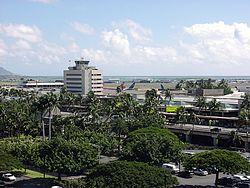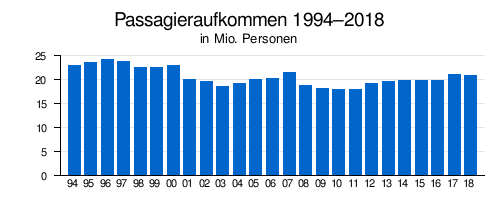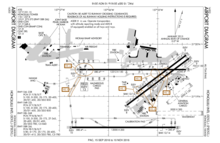Daniel K. Inouye International Airport
| Daniel K. Inouye International Airport | |
|---|---|

|
|
| Characteristics | |
| ICAO code | PHNL |
| IATA code | HNL |
| Coordinates | |
| Height above MSL | 4 m (13 ft ) |
| Transport links | |
| Distance from the city center | 3 miles west of Honolulu |
| Street | Interstate H-1 |
| train | Honolulu Rail Transit (planned for 2019) |
| Local transport | TheBus lines 19, 20 and 31 |
| Basic data | |
| opening | 1927 |
| operator | Hawaii Department of Transportation |
| Terminals | 3 |
| Passengers | 20,990,932 (2018) |
| Air freight | 531,050 t (2018) |
| Flight movements |
295,233 (2018) |
| Runways | |
| 04R / 22L | 2743 m × 46 m asphalt |
| 04L / 22R | 2119 m × 46 m asphalt |
| 08R / 26L | 3658 m × 61 m asphalt |
| 08L / 26R | 3749 m × 46 m asphalt |
| 8W / 26W | 1524 m of water |
| 4W / 22W | 914 m of water |
The Daniel K. Inouye International Airport (formerly Honolulu International Airport ) is the main airport of Honolulu . It is located on the island of Oahu ( Hawaii ). Honolulu is a major hub in the Pacific between Asia and the United States . The Joint Base Pearl Harbor-Hickam also uses the runways as a military airfield .
history
In 1925, the Territory of Hawaii approved $ 45,000 (today's equivalent of $ 655,000) for an airfield near Honolulu. The condition was that private sources had to contribute $ 20,000; this sum was raised by the Chamber of Commerce . In the same year, 885 acres of land were purchased, including 766 acres that are underwater at high tide .
In 1927 the airport was opened as John Rodgers Airport , named after naval officer John Rodgers , who among other things made one of the first attempts at a non-stop flight from the American mainland to Hawaii.
Two airlines explored possible inter-island flights in 1928 and 1929: Inter-Island Airways and Nevada- based Hawaiian Airways . On November 11th, Inter-Island Airways began scheduled operations with connections to Molokai , Maui , Hilo and Kauai - with prices between 17.50 and 32 dollars (the equivalent of 260 and 480 dollars today) and nine kilograms of baggage allowance per passenger .
In 1930, a start was made to add 30,000 cubic meters of coral to make more space for the runways . The main runway was extended to 2,200 ft (671 m) and widened to 550 ft (168 m), the runway for crosswind operations was extended to 2,050 ft (625 m) and widened to 250 ft (76 m). For the first time, the labor deployment of prisoners was used, who also leveled land for the airport and kept it free of vegetation in the following years. From 1935, the runways were again extended with funds from the Works Progress Administration .
In 1935 Pan American Airways started flights between the American mainland and Honolulu, which were later extended to Asia. Since Pan Am used flying boats like the Sikorsky S-42 on this connection , John Rodgers Airport was not used. In 1939, plans were developed to set up a flying boat port in Keehi Lagoon, the excavation should serve to expand John Rodgers Airport. In 1940 and 1941, Congress released several million dollars for this plan, and work began in October 1941. In addition, the United States Army released over 30,000 acres of Hickam Field, built directly adjacent in 1935, for further expansion of John Rodgers Airport.
After the Japanese attack on Pearl Harbor and the United States' entry into World War II , all Hawaiian airports were taken over by the military and civilian air traffic ceased. Hawaiian Airlines was given permission to operate urgent flights under military supervision, e.g. B. for the transport of medicine, ammunition and technicians.
By September 1944, the United States Army Corps of Engineers completed a connection between Hickam Field and John Rodgers Airport with the excavation of the Keehi Lagoon. John Rodgers Airport received four runways and was designated Naval Air Station Honolulu , used by the Army and Navy.
After the end of World War II, the airport was returned to the territory on October 1, 1946, and the three runways last used by the Navy for flying boats were given up. In 1947, the airport was renamed Honolulu Airport to avoid confusion in operations and ticket issuance . Temporary buildings erected during the war were used as reception buildings: a terminal for flights between the islands on the north side and a terminal for overseas flights on the south side.
After the United States Air Force leased an area it owned between the airport and Hickam Field to the airport for 20 years in 1950, the runway systems could be connected and expanded, and the resulting joint runway 8/26 became with 13,097 ft (3,992 m) the longest runway in the world.
In December 1955, a De Havilland DH.106 Comet landed for the first time a civil aircraft with jet engines at Honolulu Airport. The airlines represented at the airport announced that they would switch to mainland traffic to jets by 1959. In order to adapt to the changing requirements as a result, new reception buildings were built from 1959, including a separate Interisland Terminal for destinations on the Hawaiian islands and separate facilities for domestic flights and international connections.
On August 22, 1962, the John Rodgers Terminal was officially inaugurated with the first official jet arrival, a Pan-Am flight from San Francisco. Operations at the old terminal ceased on October 14, 1962; shortly after midnight the first flight from the new terminal to Japan took off.
In 1965, Honolulu Airport was used by nearly three million passengers, including 1.8 million at the John Rodgers Terminal. In view of the announcement of large aircraft such as the Douglas DC-8 Series 61 and the Boeing 747 in the mid-1960s and the generally expected start of civilian supersonic flights in the 1970s, planning for a further expansion began. From October 1967, General Lyman Field in Hawaii was also able to handle jet planes and thus contributed to the relief of Honolulu Airport.
In 1969 construction began on the new Diamond Head Gull Wing, which was inaugurated on March 3, 1970 with the first arrival of a Pan Am 747. At the same time, the Ewa Gull Wing for international flights was built on the opposite side and was inaugurated in 1972.
Construction work on a 12,500 ft (3,810 m) long runway called Reef Runway began in 1974, after objections from environmental protection associations had obtained construction stops in 1972 and 1973.
In 1976, Honolulu Airport handled more than 12 million passengers. Following the enactment of the Airline Deregulation Act by President Jimmy Carter in 1978, 15 airlines applied for line rights between Hawaii and the American mainland for the first time in 1979. American Airlines , Braniff International Airways , Continental Airlines , Delta Air Lines , Eastern Air Lines , Hawaiian Airlines , National Airlines , Ozark Air Lines , PSA Airlines , Trans Caribbean Airways , Trans International Airlines , Western Airlines and World Airways .
Due to the increasing volume of passengers - in 1981 Honolulu was already the 15th largest airport in the world - all terminals were expanded again in the 1980s, the Inter-Island Terminal was given passenger boarding bridges for the first time . In 1985 the airport was connected to the Interstate H-1 Highway.
Modernization since 2006
In March 2006, Governor Linda Lingle announced a major modernization program for the Hawaiian airports. Over a period of 12 years, USD 1.7 billion is to be invested in the airport. Among other things, projects should be carried out within the first 5 years to improve the service for passengers and increase safety and efficiency in operation. As part of the modernization, u. a. New information monitors installed and new sales areas and restaurants set up, and a new parking garage was completed.
The name of the airport was changed to Daniel K. Inouye International Airport on April 27, 2017, in honor of the late US Senator Daniel Inouye .
Airlines and Destinations
Local airlines for Hawaii include Hawaiian Airlines and Mokulele Airlines .
Important US airlines are American Airlines , Delta Airlines and United Airlines .
There are no non-stop flights to Europe, you either have to change trains on the US mainland (mostly in Los Angeles or San Francisco) or in Asia (mostly in Tokyo). The total travel time from Europe is around 20 hours.
Before entering the country, every passenger, irrespective of their origin, must fill out a form on which they indicate whether they are traveling with plants or animals. This is to serve to protect the flora and fauna of Hawaii. When leaving the country, every piece of luggage is examined for possible plants or animals before check-in.
Numerous Asian airlines such as Japan Airlines , Korean Air or Philippine Airlines also fly to Honolulu.
On 19 January 2011, a landing Airbus A340-600 of Lufthansa as part of a charter flight non-stop from Munich Coming on the Honolulu International Airport. This represents a new record flight for Lufthansa.
The destinations with the most passengers in 2016 were Tokyo (1.5 million), Los Angeles (1.1 million) and Kahului (1 million).
Honolulu Airport handles 70 percent of all international flights to Hawaii.
Traffic figures

| year | Passenger volume | Air freight ( tons ) | Airmail (tons) | Flight movements |
|---|---|---|---|---|
| 2018 | 20,990,932 | 480.166 | 50,884 | 295.233 |
| 2017 | 21,232,359 | 488,647 | 53,275 | 311,722 |
| 2016 | 19.950.125 | 375.780 | 97.196 | 314,530 |
| 2015 | 19,869,707 | 375.031 | 89,016 | 312,655 |
| 2014 | 19,808,497 | 375.027 | 79,527 | 311,138 |
| 2013 | 19,706,718 | 354,460 | 63,897 | 290.237 |
| 2012 | 19.293.941 | 347.454 | 64,769 | 278.145 |
| 2011 | 18,043,203 | 314,596 | 68,611 | 263.354 |
| 2010 | 18,443,873 | 335.078 | 105.260 | 263,440 |
| 2009 | 18.171.937 | 306.701 | 80,932 | 274.434 |
| 2008 | 18,809,103 | 325,707 | 85.101 | 286,593 |
| 2007 | 21,517,476 | 352.944 | 89,511 | 310.607 |
| 2006 | 20.268.376 | 346.293 | 92,783 | 317.317 |
| 2005 | 20.179.634 | 362.454 | 94.181 | 330.506 |
| 2004 | 19,334,674 | 304,833 | 76.160 | 320,520 |
| 2003 | 18,690,888 | 313,348 | 73.985 | 301.919 |
| 2002 | 19,749,905 | 334,447 | 80.126 | 323.726 |
| 2001 | 20.151.936 | 250,329 | 86,998 | 327.006 |
| 2000 | 23,027,674 | 353.082 | 97,645 | 345,771 |
| 1999 | 22,560,399 | 390,521 | 98,548 | 346,609 |
| 1998 | 22,636,354 | 351,518 | 92.046 | 334.046 |
| 1997 | 23,880,346 | 413.126 | 87,255 | 358.784 |
| 1996 | 24,326,737 | 348,654 | 87,120 | 372.268 |
| 1995 | 23,672,894 | 328.434 | 88,334 | 373.926 |
| 1994 | 22,995,976 | 339.413 | 89,724 | 359,569 |
Busiest routes
| rank | city | Passengers | airline |
|---|---|---|---|
| 1 | Los Angeles , California | 1,154,440 | Alaska , American , Delta , Hawaiian , Sun Country , United |
| 2 | Kahului , Hawaii | 984.430 | Hawaiian, Mokulele |
| 3 | Lihue , Hawaii | 650.910 | Hawaiian |
| 4th | Kona , Hawaii | 632.320 | Hawaiian, Mokulele |
| 5 | San Francisco , California | 586.380 | Alaska, Delta, Hawaiian, Sun Country, United |
| 6th | Hilo , Hawaii | 511.630 | Hawaiian |
| 7th | Seattle , Washington | 353.860 | Alaska, Delta, Hawaiian |
| 8th | Las Vegas , Nevada | 234,330 | Delta, Hawaiian |
| 9 | Phoenix , Arizona | 194,340 | American, Hawaiian |
| 10 | Dallas / Fort Worth , Texas | 166,490 | American |
Incidents
- On June 27, 1969, the hydraulic system for brakes and nose wheel control failed on a Vickers Viscount 754D of Aloha Airlines ( aircraft registration number N7410) while taxiing at Honolulu Airport. Thereupon it collided with a parked Douglas DC-9-31 (N906H) of the Hawaiian Airlines . The Viscount was irreparably damaged, the DC-9 could be repaired. The main cause were maintenance errors.
Web links
- Official site of the Daniel K. Inouye International Airport (Engl.)
- Arrival of the HNL ( Memento from September 27, 2007 in the Internet Archive )
- Departure HNL ( Memento from September 27, 2007 in the Internet Archive )
Individual evidence
- ↑ Airlines. Airports.Hawaii.gov/HNL, accessed October 16, 2019 .
- ↑ a b c d e Publications and Statistics. Hawaii.gov, accessed October 16, 2019 .
- ↑ a b c d e f Hawaii's aviation history ( English ) State of Hawaii. Retrieved October 1, 2012.
- ↑ a b c d e f g Hawaii's aviation history 1930–1939 ( English ) State of Hawaii. Retrieved October 1, 2012.
- ↑ a b c d e f g h i j Hawaii's aviation history 1940–1949 ( English ) State of Hawaii. Retrieved October 1, 2012.
- ↑ a b Hawaii's aviation history 1950–1959 ( English ) State of Hawaii. Retrieved October 3, 2012.
- ↑ a b c d e f g Hawaii's aviation history 1960–1969 ( English ) State of Hawaii. Retrieved October 10, 2012.
- ↑ a b c d Hawaii's aviation history 1970–1979 ( English ) State of Hawaii. Retrieved October 10, 2012.
- ↑ a b c Hawaii's aviation history 1980–1989 ( English ) State of Hawaii. Retrieved October 21, 2012.
- ↑ Honolulu airport renamed after late Sen. Daniel Inouye , accessed May 22, 2017
- ^ Bureau of Transportation Statistics , accessed May 22, 2017
- ↑ Tourism Carries “Sub-Par” Hawaii Economy ( Memento of the original from June 16, 2017 in the Internet Archive ) Info: The archive link was inserted automatically and has not yet been checked. Please check the original and archive link according to the instructions and then remove this notice. Hawaiibusiness.com, January 2013, Retrieved June 23, 2017.
- ↑ Honolulu, HI: Daniel K Inouye International (HNL). Transtats.BTS.gov , accessed October 16, 2019 .
- ↑ Accident report Viscount 700D N7410 , Aviation Safety Network (English), accessed on February 8, 2019.


